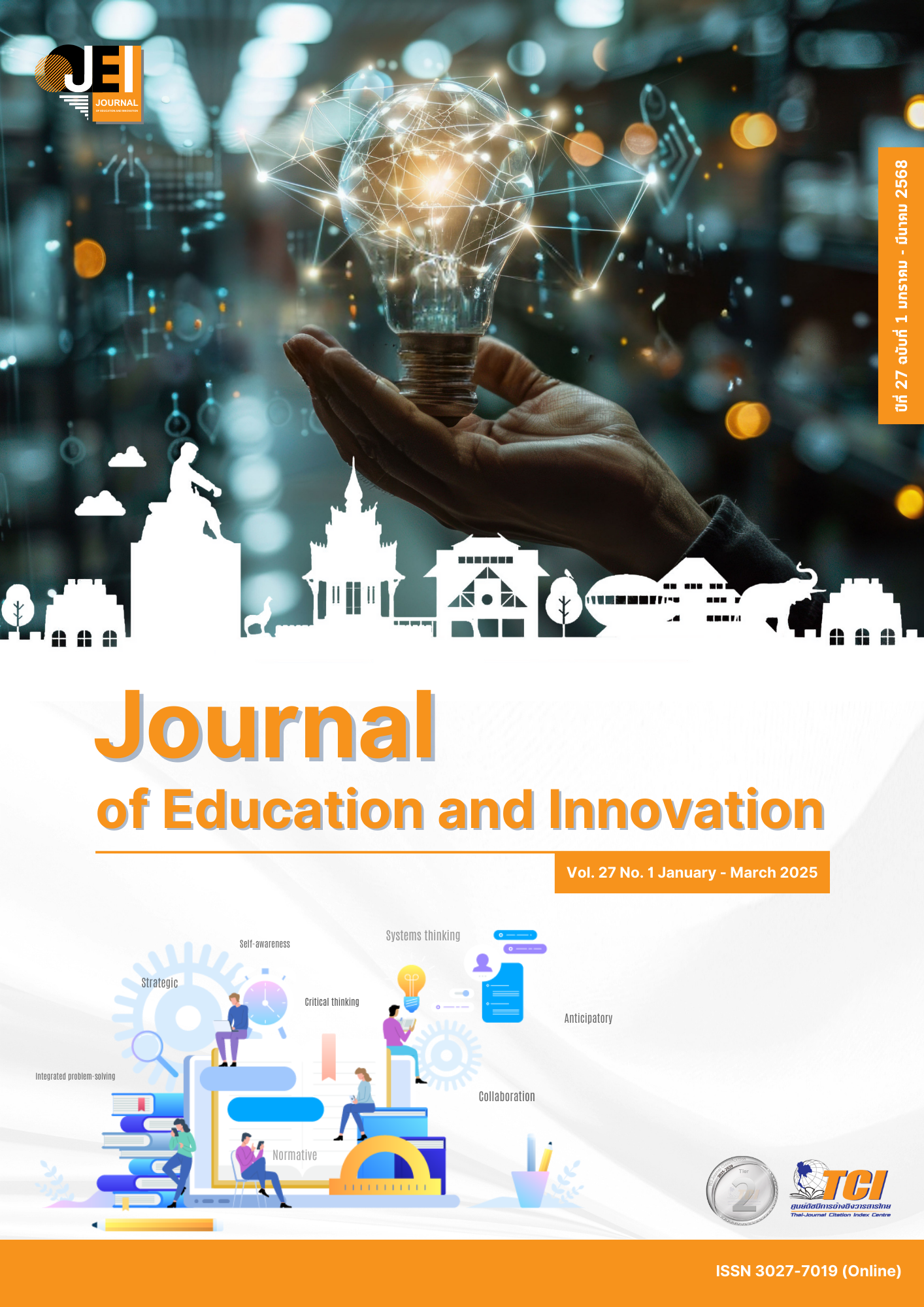THE DEVELOPMENT OF LEARNING ACTIVITY PACKAGE USING GENERATIVE AI TO ENHANCE THE ENGLISH WRITING SKILLS OF GRADE 9 STUDENTS THROUGH IMAGE CREATION
Main Article Content
Abstract
This research aims to develop a learning activity package using Generative AI to create images to enhance the English sentence writing skills of Grade 9 students. The study was conducted at the Naresuan University Secondary Demonstration School of during the 2024 academic year, with a population of 269 Grade 9 students and a sample size of 38 students. This research is a development study in which the researcher designed a learning activity utilizing Generative AI to create images and had the learning activity package evaluated by 5 experts. The activity was then tested to compare the students' ability to write English sentences before and after participating in the learning activity package, along with evaluating the sample group’s satisfaction with the activity. The research findings indicated that the learning activity package was deemed highly appropriate ( = 4.71, SD = 0.55). Additionally, the trial showed a significant improvement in the sample group’s ability to write English sentences at the .05 level. Furthermore, the sample group expressed a high level of satisfaction with the learning activity package (
= 4.21, SD = 0.67).
Article Details

This work is licensed under a Creative Commons Attribution-NonCommercial-NoDerivatives 4.0 International License.
The owner of the article does not copy or violate any of its copyright. If any copyright infringement occurs or prosecution, in any case, the Editorial Board is not involved in all the rights to the owner of the article to be performed.
References
Aki, A. N., & Rorintulus, O. A. (2023). A systematic review: The use of pictures in teaching simple present tense sentence construction to junior high school students. Journal of English Language Teaching, Literature and Culture, 2(1), 40–50. DOI: 10.53682/jeltec.v2i1.6231
Amnuaiphanwilai, T. (2023). Development of gamification learning activities using point collection cards in Line Official to promote learning motivation on the topic of application design and development for grade 9 students. Journal of Academic Research, 6(3), 277–292. DOI: 10.14456/jra.2023.69
Chan, C. K. Y., & Hu, W. (2023). Students’ voices on generative AI: Perceptions, benefits, and challenges in higher education. International Journal of Educational Technology in Higher Education, 20. DOI: 10.1186/s41239-023-00411-8
Engcouncil. (2024). Warning for using AI in learning English: Advantages and cautions. Retrieved from https://engcouncil.com/ai-english-learning/
Jangkit, P. (2002). Developing reading ability and English writing of Mathayom 6 students using the DR-TA model together with brain-based learning (Master thesis). Bangkok: Srinakharinwirot University.
Ministry of Education. (2009). Core curriculum for basic education B.E. 2551. Bangkok: Cooperative Printing House of Thailand.
Parrott, M. (2000). Grammar for English language teachers. Cambridge: Cambridge University Press.
Pratumrat, S. (2024). The development of English vocabulary learning through multimedia pictures for students in schools under the jurisdiction of non-formal education. Journal of Mani Chettha Ram Wat Chommani, 7(1), 114-127.
Pimpisiththavorn, R. (2018). Development of English writing skills using skill development exercises for grade 5 students (Master thesis). Nakhon Pathom: Silpakorn University.
Ryan Group. (2024). Generative AI in education: Shaping the future of learning. Retrieved November 25, 2024, from https://www.ryangroup.org/blog/generative-ai-in-education-shaping-the-future-of-learning/
Soliman, M., Ali, R. A., Khalid, J., Mahmud, I., & Ali, W. B. (2024). Modelling continuous intention to use generative artificial intelligence as an educational tool among university students: Findings from PLS-SEM and ANN. Journal of Computing in Higher Education. DOI: 10.1007/s40692-024-00333-y
Srisa-ard, B. (2002). Preliminary research (7th ed.). Bangkok: Suwiriyasan.
Subur, A., Juhansar, J., Jubba, H., Pabbajah, M., & Clarita, N. A. (2023). Uncovering students’ ability in writing simple sentences using pictures. Acitya: Journal of Teaching and Education, 5(1), 1–22. DOI: 10.30650/ajte.v5i1.3293
Surasit, N. (2002). Contemporary English grammar: Complete edition. Bangkok: P.S. Press.
Suwangvoras, B., & Pookakup, Y. (1983). Measurement of English writing ability as a foreign language using subjective and objective tests. Language Review Journal, 42, 62–67.
Yawsong, S., & Sipsang, P. (2021). Development of the ability to construct present perfect tense sentences of grade 8 students at Wat Khemaphirataram School using skill development exercises. Journal of Education Science, Suan Sunandha Rajabhat University, 5(1), 12–18.
Yilmaz, R., & Karaoglan Yilmaz, F. G. (2023). The effect of generative artificial intelligence (AI)-based tool use on students' computational thinking skills, programming self-efficacy, and motivation. Computers and Education: Artificial Intelligence, 4, Article 100147. DOI: 10.1016/j.caeai.2023.100147

